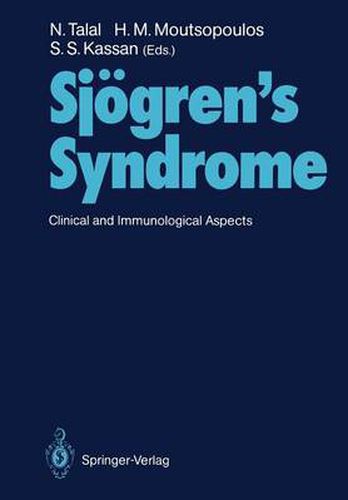Readings Newsletter
Become a Readings Member to make your shopping experience even easier.
Sign in or sign up for free!
You’re not far away from qualifying for FREE standard shipping within Australia
You’ve qualified for FREE standard shipping within Australia
The cart is loading…






This title is printed to order. This book may have been self-published. If so, we cannot guarantee the quality of the content. In the main most books will have gone through the editing process however some may not. We therefore suggest that you be aware of this before ordering this book. If in doubt check either the author or publisher’s details as we are unable to accept any returns unless they are faulty. Please contact us if you have any questions.
I have been a student of Sjogren’s syndrome for virtually all of my professional life. My education in this disease began in 1962 when I arrived at the National Institutes of Health to begin a Clinical Asso- ciateship with Dr. Joseph J. Bunim. Bunim introduced me to a pat- ient with Sjogren’s syndrome of 8 years duration who had devel- oped malignant lymphoma 6 months previously. He told me that there were other such patients. I obtained serum samples from these patients and studied them by the then new technique of immuno- electrophoresis. We observed that an initial hypergammaglobulin- emia could progressively decline to hypogammaglobulinemia with loss of autoantibodies. One patient in this initial series had macrog- lobulinemia. We published this report and suggested that the auto- immunity predisposed to the malignant transformation. Thus began my love affair with this disease. In those days many rheumatologists considered Sjogren’s syn- drome simply a variant of rheumatoid arthritis. It’s curious that two decades ago there was little confusion between Sjogren’s syndrome and systemic lupus erythematosus, whereas today there is great con- fusion. There is still a great need for internationally agreed upon di- agnostic criteria, which merely illustrates once again the difficulty of accurate diagnosis in our profession. The multidisciplinary aspects of Sjogren’s syndrome require au- thorities in several areas of medicine. The various chapter contribu- tors are experts in their field and have often put aside other respon- sibilities to complete their contributions and not delay publication.
$9.00 standard shipping within Australia
FREE standard shipping within Australia for orders over $100.00
Express & International shipping calculated at checkout
This title is printed to order. This book may have been self-published. If so, we cannot guarantee the quality of the content. In the main most books will have gone through the editing process however some may not. We therefore suggest that you be aware of this before ordering this book. If in doubt check either the author or publisher’s details as we are unable to accept any returns unless they are faulty. Please contact us if you have any questions.
I have been a student of Sjogren’s syndrome for virtually all of my professional life. My education in this disease began in 1962 when I arrived at the National Institutes of Health to begin a Clinical Asso- ciateship with Dr. Joseph J. Bunim. Bunim introduced me to a pat- ient with Sjogren’s syndrome of 8 years duration who had devel- oped malignant lymphoma 6 months previously. He told me that there were other such patients. I obtained serum samples from these patients and studied them by the then new technique of immuno- electrophoresis. We observed that an initial hypergammaglobulin- emia could progressively decline to hypogammaglobulinemia with loss of autoantibodies. One patient in this initial series had macrog- lobulinemia. We published this report and suggested that the auto- immunity predisposed to the malignant transformation. Thus began my love affair with this disease. In those days many rheumatologists considered Sjogren’s syn- drome simply a variant of rheumatoid arthritis. It’s curious that two decades ago there was little confusion between Sjogren’s syndrome and systemic lupus erythematosus, whereas today there is great con- fusion. There is still a great need for internationally agreed upon di- agnostic criteria, which merely illustrates once again the difficulty of accurate diagnosis in our profession. The multidisciplinary aspects of Sjogren’s syndrome require au- thorities in several areas of medicine. The various chapter contribu- tors are experts in their field and have often put aside other respon- sibilities to complete their contributions and not delay publication.